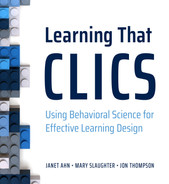Make Learning Stick Through Deeper Analysis Achieving lasting learning starts with understanding our psychology—how we process, retain, and apply learning in our everyday work. It also starts with understanding how our brains work and how they receive, process, encode, and recall information—the essence of learning. Without factoring in these realities, behavior change at scale will remain unnecessarily difficult. Learning That CLICS: Using Behavioral Science for Effective Learning Design introduces the CLICS framework, a concise, practical way to apply brain science and a human-centric approach to the art of learning design. Created by learning practitioners for learning practitioners, the CLICS framework covers five domains that deepen analysis and increase the likelihood that learning will occur. Capacity considers our brain’s cognitive space for learning given our current work priorities. Layering fills in learning gaps and the knowledge we need before integrating new concepts. Intrinsic enablers address motivation and personal relevance. Coherence ensures the “fit” of concepts with one another as well as how new concepts will relate to past learning experiences. Social connections—peers, managers, experts, and others in our work environment—offer feedback and modeling, helping us to learn optimally and be effective. Once we appreciate how our brains learn, our ability to conduct a CLICS analysis can promote giant leaps forward and ensure learning that lasts.
Table of Contents
- Cover
- Title Page
- Copyright
- Dedication
- Contents
- Contributor Sections
- Prologue: Standing on a Foundation of Continual Change
- Chapter 1: Discovering CLICS: A Stronger Approach to Analysis
- Chapter 2: Our Brains and the Science of Learning
- Chapter 3: Applying Capacity
- Chapter 4: Applying Layering
- Chapter 5: Applying Intrinsic Enablers
- Chapter 6: Applying Coherence
- Chapter 7: Applying Social Connections
- Chapter 8: The CLICS Tool in Total
- Chapter 9: CLICS in Design and Development
- Chapter 10: The Future of Workplace Learning
- Acknowledgments
- Appendix: A Brief Tutorial on the Science of Testing Programs
- References
- Index
- About the Authors
